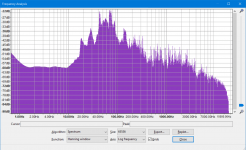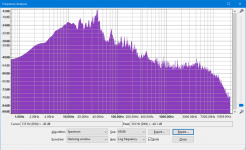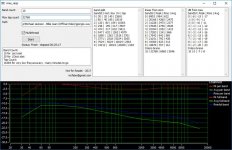Sorry, but having 12 or 100 18" subs or a car stereo that will rattle the windows does not mean that music IN GENERAL has much content below 30Hz. Now you may be able to play below 20-30Hz, and you might be able to EQ up the octave below 40Hz so that you hear what is down there - but the real levels below about 40Hz on the vast majority of recordings is minimal.
I don't think anyone has ever disagreed with this. For that matter I've said the same thing in different words a few times. In statistical terms you are correct.
People are still confusing what's actually in the recording with the way they like to play it. And (I think) still confusing bass amplitude with frequency.
THIS is the part being regularly disagreed with. I'm not sure why you think people don't know what they are listening to. There are several bass content master charts, it's easy enough to measure your own content, word of mouth spreads like CRAZY. When Edge of Tomorrow came out, within a few hours the WHOLE WORLD (the part that cares) knew it had devastating and possibly damaging low tones. And that caused probably more than a million sales of that movie by people that specifically search that out.
Think about that. Probably well over a million sales based only on a few tones that have nothing to do with the rest of the movie in any way, they are just there. People that didn't know what the movie was about, people that don't like Tom Cruise bought that movie specifically because it's on the bass content master list.
That's just one example. Why can't you understand that people are aware of what's in their media and specifically seek it out? Some girls like rom coms and a disproportionate amount of their collection will contain romance movies. Why is it hard to understand that the people that spend thousands on subs and maybe even modify their house to fit it in will gravitate to media with low bass? There's plenty of it out there and it's not hard to find, it's all on a nice list with pictures of measured frequency response.
Having said all that, people that don't care about bass will occasionally procure a track with low bass and they will miss out because they can't reproduce it. That's life, we all choose our own path.
Also, do not dismiss a couple of earlier posts. A full spectrum playback ABSOLUTELY does sound different than a high pass one (whether the high pass is electrical or created by speakers that can't play low).
And more low bass media is being created at an exponential rate because people now have the capability to easily play it back. Times are changing and as sure as modern music has more bass than 50's recordings, future music will have a lot more low bass than current music.
And more low bass media is being created at an exponential rate because people now have the capability to easily play it back. Times are changing and as sure as modern music has more bass than 50's recordings, future music will have a lot more low bass than current music.
Please do not alter what I (or anyone else) says in quotes. It's unfair to the person quoted and against the Rules. When you quote, don't add your own words to what someone else said.
And you also know full well that the EDM and hip-hop tracks I analyzed are not from the 1950s, so that's an invalid point. I certainly agree that recent music has much more bass than older recordings, that's evident in some of the music genres I analyzed. But is that augmented bass really below 40Hz? Or is it just more level in the normal bass regions? Movies sound tracks are not part of the original question, music is.
Sure, there are specific tracks favored by bass fans, and some have very low bass. Most music doesn't, tho. Your argument is akin to someone asking "How many recordings have flutes in them?" and you take a look at a few hundred and say "About 15% do, based on a broad selection of popular recordings." Then I come back and say "No, 99% do, based on my collection of Jethro Tull recordings." Again, missing the point of the original question.
And you also know full well that the EDM and hip-hop tracks I analyzed are not from the 1950s, so that's an invalid point. I certainly agree that recent music has much more bass than older recordings, that's evident in some of the music genres I analyzed. But is that augmented bass really below 40Hz? Or is it just more level in the normal bass regions? Movies sound tracks are not part of the original question, music is.
Sure, there are specific tracks favored by bass fans, and some have very low bass. Most music doesn't, tho. Your argument is akin to someone asking "How many recordings have flutes in them?" and you take a look at a few hundred and say "About 15% do, based on a broad selection of popular recordings." Then I come back and say "No, 99% do, based on my collection of Jethro Tull recordings." Again, missing the point of the original question.
Bottom A on grand piano 27.5Hz, not often played but sustain pedal often usedNo sense chasing notes that don't exist anyway
Cubo Sub - YouTube
This playlist only contains songs that benefit from a subwoofer going down to 30-ish Hz, if the sub only goes down to 40 Hz, you're missing out on something... Most of these songs, played on a subwoofer that goes down to 17 Hz, show little or no improvement in perceived sub bass.
Yes, quite a few of these songs were made by 'young money millionaires' (successful artists/ popular songs).
Many of these songs have the bass output peak at 63 Hz, with 25 - 30 Hz being 10 dB down from there. Some of these also have a secondary beat/ sub content that's of the same, or lower amplitude below 40 Hz. However as these peak at 40 Hz and have less output around 50 - 63 Hz they're often perceived as going lower.
Johan
This playlist only contains songs that benefit from a subwoofer going down to 30-ish Hz, if the sub only goes down to 40 Hz, you're missing out on something... Most of these songs, played on a subwoofer that goes down to 17 Hz, show little or no improvement in perceived sub bass.
Yes, quite a few of these songs were made by 'young money millionaires' (successful artists/ popular songs).
Many of these songs have the bass output peak at 63 Hz, with 25 - 30 Hz being 10 dB down from there. Some of these also have a secondary beat/ sub content that's of the same, or lower amplitude below 40 Hz. However as these peak at 40 Hz and have less output around 50 - 63 Hz they're often perceived as going lower.
Johan
Please do not alter what I (or anyone else) says in quotes. It's unfair to the person quoted and against the Rules. When you quote, don't add your own words to what someone else said.
Sorry, I made it all caps and bold to make it clear that it was added, I guess that's not enough. Without that clarification I couldn't agree with your quote 100 percent but I guess I should have done it in a different way.
And you also know full well that the EDM and hip-hop tracks I analyzed are not from the 1950s, so that's an invalid point. I certainly agree that recent music has much more bass than older recordings, that's evident in some of the music genres I analyzed. But is that augmented bass really below 40Hz? Or is it just more level in the normal bass regions? Movies sound tracks are not part of the original question, music is.
Sure, there are specific tracks favored by bass fans, and some have very low bass. Most music doesn't, tho. Your argument is akin to someone asking "How many recordings have flutes in them?" and you take a look at a few hundred and say "About 15% do, based on a broad selection of popular recordings." Then I come back and say "No, 99% do, based on my collection of Jethro Tull recordings." Again, missing the point of the original question.
Round and round we go. I'm not disagreeing with you and can't fathom why you are disagreeing with me. I've made it very clear that MOST music statistically has no useful information below 30 hz. I've clearly explained that there is however LOTS of music with useful information below 30 hz, more than enough to satisfy a lifetime of listening, and there's only going to be more in the future. If you want it, it's easy to find. I've clearly stated that unless you really care about those low tones it's best not to even bother trying to reproduce them.
Your argument has consistently been that most music contains no useful information below 30 hz. No one ever disagreed with that. Also you state that most people don't really know there isn't any useful information below 30 hz. This is the problem, I've shown plenty of evidence that it just takes a quick search or scan to find out.
I'm going to have to quit now, you keep arguing a point that no one disagrees with and won't concede to the other point that we (or at least I) know very well what frequencies are in my tracks. There's no point in dragging this out so instead I just quit.
Bottom A on grand piano 27.5Hz
But how much fundamental is radiated from that? (I don't actually know, but the surface area of a piano string is essentially diddly-squat, and I can't see the sounding board having a lot of excursion).
Remember that a musical fundamental is basically the spacing between overtones, not necessarily the frequency of the highest sinusoid in the note.
It's right here in the next thread over. 🙂But how much fundamental is radiated from that?
Post # 137 in case the link doesn't work
http://www.diyaudio.com/forums/subwoofers/312324-low-music-movies-14.html#post5221564
If you look back and actually read what I wrote, you'll see that I did concede that several times, but said it isn't common or usual in most music, even EDM or hip-hop....won't concede to the other point that we (or at least I) know very well what frequencies are in my tracks.
So I can't understand why you are hung up on that point.
People are still confusing what's actually in the recording with the way they like to play it. And (I think) still confusing bass amplitude with frequency.
I can see you like to cherry pick what suits you, even if those cherries are a long stretch. 😉 That's been your entire argument so far. OK, fine. No need to worry about reaching. I attempted to answer the original question with real data. I stand by that data.
Quote:
Bottom A on grand piano 27.5Hz
Quote
"But how much fundamental is radiated from that? (I don't actually know, but the surface area of a piano string is essentially diddly-squat, and I can't see the sounding board having a lot of excursion)."
The piano sound board is very large and moves a huge amount of air with its relatively small "excursion".
Hitting a long note: one of world's largest pianos finds a grand stage | Music | The Guardian
Bottom A on grand piano 27.5Hz
Quote
"But how much fundamental is radiated from that? (I don't actually know, but the surface area of a piano string is essentially diddly-squat, and I can't see the sounding board having a lot of excursion)."
The piano sound board is very large and moves a huge amount of air with its relatively small "excursion".
An externally hosted image should be here but it was not working when we last tested it.
Hitting a long note: one of world's largest pianos finds a grand stage | Music | The Guardian
I think people are underestimating the amount of stuff going on way down low. Here are some FFTs of music in my collection as examples. The first one, by the aptly named LFO, has some clear peaks at 18Hz and 28Hz. The second one, by Nostrum, has some fairly loud bass with a 25Hz fundamental. The third one, an Aphex Twin remix of The Prodigy's Breathe speaks for itself.
While most of what I listen to falls off rapidly below 40Hz, there is enough like the above that listening on a system which goes down to 20Hz, or even lower, is a very different experience to listening on one that only reaches 40Hz.
While most of what I listen to falls off rapidly below 40Hz, there is enough like the above that listening on a system which goes down to 20Hz, or even lower, is a very different experience to listening on one that only reaches 40Hz.
Attachments
Ever since 1928, with the introduction of Theremin's electronic synthesis, manipulation of fundamental frequencies in relation to the harmonics has been possible. Initially, electronic instruments attempted to duplicate the usual harmonic structure of typical acoustic instruments.I can see you like to cherry pick what suits you, even if those cherries are a long stretch. 😉 That's been your entire argument so far. OK, fine. No need to worry about reaching. I attempted to answer the original question with real data. I stand by that data.
The advent of readily available digital recording and playback in the mid-1980s freed us of the low frequency limitations of vinyl playback media, and the availability of relatively inexpensive high displacement woofers in the 1990s made it possible to reproduce low frequencies at levels that would only occur acoustically with instruments like 60" diameter drums and pipe organs.
The entire recording process now allows the artist, recording, and playback to be virtually unlimited in low frequency reproduction and harmonic structure as it previously had been by technological or monetary restrictions. The answer to the question "realistically, how low is bass in music?" is now entirely dependent on the music one listens to, and how accurately (or exaggerated) one wishes to hear that music.
As consumers, we can now decide individually the importance of low frequency contribution to our music or "home theater" experience, and whether we deem the added expense and size required for the LF extension to be "worth it" at whatever level we decide to achieve.
Personally, the octave from 20 to 40 Hz has as much musical importance as the octave from 10 to 20kHz, though I am satisfied with home levels of 100 dB, which does not require "heroic" power, size or expense.
That said, for most music, those two octaves are the least important to me-although I wouldn't miss them on most music if they were not available, after hearing the contribution they make on certain tracks, I do miss those frequencies when they aren't.
Art
Are these sales figures from a published source or are they simply your opinion?When Edge of Tomorrow came out, within a few hours the WHOLE WORLD (the part that cares) knew it had devastating and possibly damaging low tones. And that caused probably more than a million sales of that movie by people that specifically search that out.
Think about that. Probably well over a million sales based only on a few tones that have nothing to do with the rest of the movie in any way, they are just there. People that didn't know what the movie was about, people that don't like Tom Cruise bought that movie specifically because it's on the bass content master list.
That's just one example.
One other thing: It's been mentioned that a piano bass note (for one example) has more energy in the harmonics than the fundamental. But don't we still need flat response down to the fundamental frequency in order to reproduce the original proportions (and sound), even if the fundamental is much weaker?
Have a look at these posts regarding grand piano bass notes.
How LOW should we go... For Music and for Movies ?
How LOW should we go... For Music and for Movies ?
- Status
- Not open for further replies.
- Home
- Loudspeakers
- Subwoofers
- Realistically, how low is bass in music?




